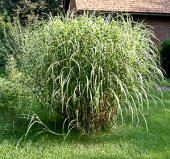In their native environments, hostas are found
growing in a large range of conditions. Some grow in woodlands while
other prefer grassy plains. Many are found growing precariously from
cracks in solid rock cliffs. Although some of these sites are shady,
many are in the full sun. Rather than sunlight, the key factor seems
to be the air temperature and moisture levels. This may be one of
the reasons that hostas will thrive in higher levels of sun exposure
in northern gardens than they do in the southern part of the U.S.
where both day and night summer temperatures tend to be much warmer.

It appears that most of the hostas that we
commonly grow in home landscapes originated from the margins of the
forest or from open grassland areas in
Asia. Other species that have
not been quite so popular to this point in the home garden often
come from quite different environments.
Hosta hypoleuca is
found growing in pretty dense shade as well as on full-sun cliffs in
the mountains.
Hosta longissima with its narrow, long leaves
is native to damp meadows and grows among tall
Miscanthus
grasses at the higher elevations on Japanese islands. The miniature
species,
Hosta venusta is sometimes found growing on moss
covered trees like an epiphyte. Sphagnum peat bogs are the home of
Hosta alismifolia while
Hosta kiyosumiensis grows on
the banks of streams and swamps.
mountains.
Hosta longissima with its narrow, long leaves
is native to damp meadows and grows among tall
Miscanthus
grasses at the higher elevations on Japanese islands. The miniature
species,
Hosta venusta is sometimes found growing on moss
covered trees like an epiphyte. Sphagnum peat bogs are the home of
Hosta alismifolia while
Hosta kiyosumiensis grows on
the banks of streams and swamps.
One other
common characteristic of the native lands of hostas is that they
all are in temperate regions of the world. This means that they
regularly experience killing frosts in the autumn and freezing
temperatures throughout the winter months. This is why most
hostas need to go into cold dormancy for part of the year.



